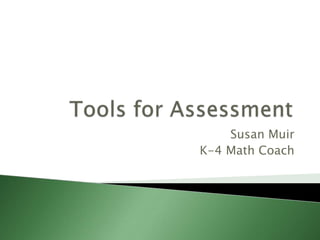
Tools for assessment
- 1. Susan Muir K-4 Math Coach
- 2. Making assessment an integral part of daily mathematics is a challenge. It requires planning specific ways to use assignments and discussions to discover what students do and do not understand. It also requires teachers to be prepared to deal with students’ responses. Merely spotting when students are incorrect is relatively easy compared to understanding the reasons behind their errors. The latter demands careful attention and deep knowledge of the mathematic concepts and principles that students are learning… The insights we gain by making assessment a regular part of instruction enable us to meet the needs of students who are eager for more challenges and to provide intervention for those who are struggling. Burns 2005, p.31
- 3. After reading that passage: Jot down the challenges that you face making assessment a part of daily mathematics instruction? What are two ways that would help you overcome these challenges?
- 5. Formative Assessment: Assessment and teaching should be integrated into a whole Ongoing assessment allows teachers to monitor students on a daily basis and modify teaching based on what students need to be successful Improves our teaching practices Provides students with timely feedback that they need to make adjustments to their learning.
- 7. P3.1 Demonstrate understanding of increasing and decreasing patterns including: observing and describing extending comparing creating patterns using manipulatives, pictures, sounds, and actions. N3.1 Demonstrate understanding of whole numbers to 1000 (concretely, pictorially, physically, orally, in writing, and symbolically) including: representing (including place value) describing estimating with referents comparing two numbers ordering three or more numbers.
- 8. What will the children do to know that the learning has occurred? What should children do to demonstrate the understanding of the mathematical concepts, skills, and big ideas? What assessment tools will be the most suitable to provide evidence of student understanding? How can I document the children’s learning?
- 9. Anecdotal Notes and Observations Prepared Bloom’s Taxonomy Questions Opportunity for Open- Ended Thinking and Discussion 3 Point Rubric for: of and as learning
- 10. What learning opportunities and experiences should I provide to promote the learning outcomes? What will the learning environment look like? What strategies do children use to access prior knowledge and continually communicate and represent understanding? What teaching strategies and resources will I use?
- 12. What conclusions can be made from assessment information? How effective have instructional strategies been? What are the next steps for instruction? How will the gaps in the development of understanding be addressed? How will the children extend their learning?
- 13. Develops and supports student’s metacognitive skills Self assessment/Peer Assessment Make sense of information and make connections to own self Helps students set learning goals
- 14. What are the specific outcomes in the task? Begin by describing the Acceptable Level then use Bloom’s Taxonomy to identify differentiating criteria as you move up the scale. The criteria should not go on beyond the original performance task but reflect higher order thinking that students could demonstrate.
- 15. The more precise the descriptors the words are for each scale, the more reliable the tool. Measures such as frequency (always, usually, sometimes and never) are better than descriptors such as quality (fair, good, excellent)
- 16. Refer back to: Jot down the challenges that you face making assessment a part of daily mathematics instruction? What are two ways that would help you overcome these challenges? What are some new tools that you learned today that would help you with your challenges? What do you still need?
- 17. Rethinking Classroom Assessment with Purpose in Mind WNCP Learn Alberta (Assessment) http://www.learnalberta.ca/content/mewa/html/assessment/process.html Mathematics Assessment a Practical Handbook for grades K-2 NCTM 50 Tools and Techniques for Classroom Assessment by Karen Hume
Notas do Editor
- Take a moment to read the passage through once and then one more time, thinking more deeply about the words.
- -Quick write Over the next hour, we will look at two of the three components of assessment. Assessment for learning and assessment as learning. You will have a chance to look at a few samples of assessment, as well you will be creating your own assessment tools.
- In this assessment pyramid you will notice the traditional method was mainly assessment of leaning, the unit tests. It has been flipped on it’s head with the bulk of the assessment being assessment as learing with the next being assessment for learning. We will first take a look at assessment for learing.
- This type of assessment is ongoing and occurs throughout the student’s learning process. It is designed to make the student’s understanding visible, so teachers can decide what they can do to help students progress. In assessment for learning, teachers use assessment as a tool to find out what students can do, and what confusions, perceptions or gaps they might have. How do I do this? This is what takes place in the first steps of the planning process.
- Show teachers some of the tools that I have prepared for the lesson.